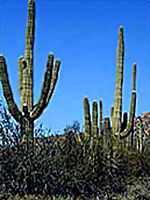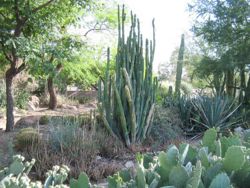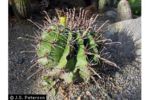Cactus
Cacti are succulent, spiny plants that easily recognized because of their distinct shapes. Most people associate cacti with the desert, but they are commonly used as household decorations. Some are even used as crop plants. Cacti can live from 25 to 300 years, can grow from 1 cm in diameter to almost 20 m in height, but all share several key features that separate them from the rest of the plant world.[1]
These extraordinary plants are found almost exclusively in the Americas. Cacti are found on other continents because of distribution by humans. Cacti introduced in other continents, however, usually turned out to be a major detriment to the land. In fact, 40,000 sq km of farmland in Australia has been rendered unusable because of the introduction of cacti.[1] A variety of Prickly Pear cactus (Opuntia stricta), now called "Common pest pear" in Australia, was recognized as a danger by 1870, and laws for its destruction were in place by 1886.[2] Between 1900 and 1925, the spread of the plant exploded, and by 1925 was completely out of control, growing at half a million hectares (2,000 square miles) per year.[2] In 1926, after much laboratory testing, a kind of caterpillar (Cactoblastis cactorum) was released as a biological control. This controlled most original stands of prickly pear so that people could return to their homes, but it was not completely effective. Another variety of prickly pear cactus called "tiger pear" (Opuntia aurantiaca) is now considered one of the worst invasive weeds in Australia[2]
Anatomy

A cactus is usually found in one of three shapes: as a tree-like plant, a shrub, or ground cover. The bodies of the cactus are used mostly for storage, because the cactus is acclimated to the desert, where water is extremely scarce. It needs a lot of storage room to store extra water for the long periods between rain. A lot of cacti also have a spherical shape in order to have the highest volume with the least surface area to prevent over-heating and allow for more storage.[3]
The needles on the outside of the cactus are actually its leaves, which are called spines. The cactus has them to use as protection against animals seeking water from it. Unlike other plants, the stem of the cactus is the only place where photosynthesis takes place. Almost all cacti are succulent plants, but that does not mean that all succulent plants are cacti. Other succulent plants do not carry out photosynthesis exclusively in the stems.[3]
Reproduction
Cacti reproduce using flowers that are pollinated by a variety of creatures, including moths, bats, hummingbirds, and bees. Other cacti produce seeds that are distributed by animals through their digestive tracts. Cacti can also reproduce asexually through regeneration. Since they can retain large amounts of water, a piece of cactus that is broken off can easily grow roots and start a new plant.[1]
Ecology
Cacti live mostly in arid deserts that receive very little rainfall each year, and are very well adapted to them. Their bodies can retain large amounts of water, and they have needles to protect themselves from water-seeking predators. These needles also prevent some of the loss of water through transpiration.[3]
Uses
Cacti are used for many different things, including gardening and food. They are a common household decoration and are especially popular in houses in warmer climates. In warm and arid climates, some cacti can be used outside as materials for fences. Still other cacti can be used for food. The prickly pear cactus produces fruit that is edible and can provide mucilage which can clean water by removing heavy metals and suspended solids. [1] Other cacti have psychoactive properties that are used by native Americans living in the Southwest. These are a few of the wide variety of uses for cacti.[4]
Gallery
Prickly Pear
(Opuntia littoralis)
Genus:OpuntiaBarrel Cactus
(Ferocactus Echidne
) Genus:FerocactusSea Urchin Cactus
(Trichocereus Chiloensis)
Genus:Trichocereus
References
- ↑ 1.0 1.1 1.2 Cactus. On Wikipedia.
- ↑ 2.0 2.1 2.2 Prickly Pear History. North West Weeds. 2 May 2013.
- ↑ 3.0 3.1 3.2 Cacti Anatomy. Biology of Cacti. Dalhousie University.
- ↑ Cacti Uses. Cactus Museum.
- Cactaceae. USDA.






